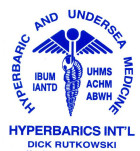Hyperbarics International has been teaching diving and clinical hyperbaric medicine for over 40 years. In that time, the understanding of physiology and pathophysiology has changed dramatically, thereby changing the approach to treating diving injuries and decompression illness.

For many years diving related injuries were treated at pressures equivalent to deeper depths. In 1965 Captain Charles Waite found that the period of the most bubble dissipation occurred between 60-90 feet. Thus, the hydrostatic pressure component of treating bubbles at 165 feet became irrelevant, and isobaric (constant pressure) counter diffusion became the leading method used in hyperbaric treatments. In addition to 60 feet being an optimal depth for dissipation of bubbles, it was also found that oxygen becomes highly toxic to the central nervous system at depths greater than 60 feet. As there is no gain in efficacy at deeper treatment depths, most hospital based chambers treating recreational divers will generally never exceed 60 feet. While there are more hyperbaric treatment facilities in operation today, it can still take an average of 4-6 hours to get a recreational scuba diver to one of these facilities.
Getting a diver suffering from any type of decompression illness (DCI) to a hyperbaric treatment facility in a timely manner is very important. Within just 10-15 minutes, gas bubbles can activate the clotting process in a person’s blood. This clotting can preclude venous and/or arterial blood flow in the region of perfusion, leading to more serious injury. Further injury can result from the body’s release of basal-active substances which lead to inflammation, swelling, reduction of blood flow, and white cell migration which can lead to further tissue injury. Fortunately, many of the initial effects of DCI are reversible with rapid access to proper treatment.
You can learn more about isobaric counter diffusion, and other issues pertaining to the treatment of treating diving casualties, through our Diver Medical Training Course and other courses.















